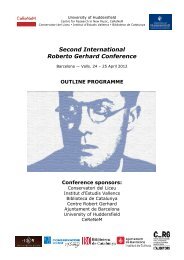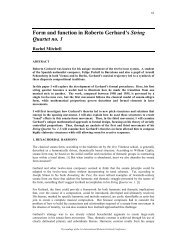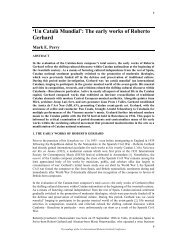the electronic music - Roberto Gerhard
the electronic music - Roberto Gerhard
the electronic music - Roberto Gerhard
Create successful ePaper yourself
Turn your PDF publications into a flip-book with our unique Google optimized e-Paper software.
Figure 1: <strong>Roberto</strong> <strong>Gerhard</strong> in his studio<br />
During <strong>the</strong> 1950s and 1960s [17], <strong>Gerhard</strong> ga<strong>the</strong>red a significant magnetic tape collection in his<br />
studio, corresponding to a major repository of historical sound recordings of his own work in<br />
which all areas of his compositional activity are represented. Following <strong>Gerhard</strong>’s death in 1970,<br />
Poldi <strong>Gerhard</strong> continued to play back <strong>the</strong> recordings, helping to identify <strong>the</strong>ir contents with her<br />
own annotations and comments. After her own death in February 1994 [18], <strong>the</strong> studio was<br />
dismantled [19] and <strong>the</strong> tapes were deposited at <strong>the</strong> Cambridge University Library with <strong>the</strong> rest of<br />
<strong>Gerhard</strong>’s archive [20]. In 2008 <strong>the</strong> inventory of <strong>the</strong> tape collection took place [21], and later that<br />
year, <strong>Gerhard</strong>’s archive was donated to <strong>the</strong> Cambridge University Library [22].<br />
2. SOUND COMPOSITION<br />
About 50% of <strong>the</strong> tapes are directly related to <strong>Gerhard</strong>’s sound compositions [23]. For those works,<br />
<strong>the</strong> magnetic tape collection is <strong>the</strong> primary source of sound documents. Excluding one remarkable<br />
exception [24] most of this work remains unpublished, and in a number of cases is not available<br />
from o<strong>the</strong>r sources. The tapes contain all different stages of production, from ingredients to multi<br />
level compounds and sound compositions [25].<br />
[…] we all have got to start in <strong>the</strong> same way: by building up a repertoire of sounds which are stored on<br />
tape. [...] The sounds selected may ei<strong>the</strong>r be appropriate in <strong>the</strong>ir original form to <strong>the</strong> sound-picture one<br />
has in mind or else require fur<strong>the</strong>r treatment before being used. Most of my stored sounds are of<br />
instrumental origin, recorded on tape through microphone. The next step -what I called my second<br />
stage - is directed towards a certain transformation of that original sound, ideally towards a<br />
metamorphosis of <strong>the</strong> sound which origins are blurred, and a far-reaching change of identity might be<br />
achieved. [<strong>Gerhard</strong> 9.116 f26-27v. Cambridge University Library.]<br />
The first stage of sound composition is to ga<strong>the</strong>r a repertoire of raw materials on tape. This task is<br />
well illustrated in ff. 1-10 of <strong>the</strong> sound score [26] for King Lear (1955), which contain detailed<br />
instructions for recording a catalogue of instrumental sounds using different dynamics and modes<br />
of attack [27]. In <strong>the</strong> studio, a microphone was available for making recordings of piano effects -<br />
Proceedings of <strong>the</strong> 1st International <strong>Roberto</strong> <strong>Gerhard</strong> Conference<br />
122





